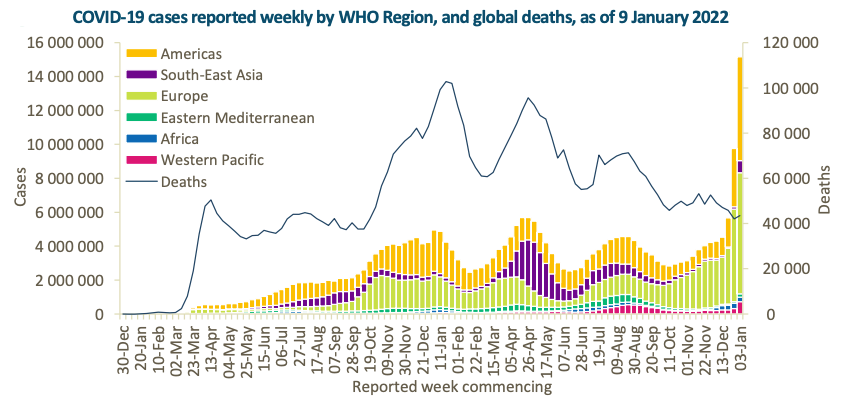
India reported 524% increase in new Covid-19 cases last week and almost 2 lakh new cases in the last 24 hours
Geneva The current global epidemiology of SARS-CoV-2 is characterized by the emergence of Omicron variant, declining prevalence of the Delta variant, and very low level circulation of Alpha, Beta and Gamma variants, the World Health Organization stated here today. Following the identification of travel related Omicron cases, many countries are now reporting clusters as well as community transmission of this Variant Of Concern (VOC). However, in terms of disease severity, there is growing evidence that the Omicron variant is less severe as compared to other variants.
The latest update on Omicron released today by WHO revealed that this variant has a substantial growth advantage and is rapidly replacing other variants. This variant has been shown to have a shorter doubling time as compared to previous variants, with transmission occurring even amongst those vaccinated or with a history of prior SARS-CoV-2 infection; there is increasing evidence that this variant is able to evade immunity.
Since the last update on December 14, 2021, six studies have provided evidence of reduced vaccine effectiveness (VE) of COVID-19 vaccines against the Omicron variant. While early VE estimates against the Omicron variant should be interpreted with caution due to potential biases, these preliminary results provide evidence of reduced overall effectiveness of vaccines against the Omicron variant, with greater declines in effectiveness with increasing time since vaccination, relative to Delta. While a booster vaccination appears to improve VE against infection and hospitalization due to the Omicron variant, more data are needed to assess both the magnitude and duration of the protection, WHO stated.
In Denmark, the first case of infection with the Omicron variant was detected on November 22, 2021, with community transmission established by late November 2021. A non-peer-reviewed preprint used Danish registers to estimate the household secondary attack rate (SAR) among Danish households during December 2021. The SAR was 31% versus 21% in households with the Omicron (total primary cases: 2225) and Delta variant (total primary cases: 9712), respectively, with the estimated SAR remaining higher for the Omicron than for the Delta variant across all groups.3 Additionally, unvaccinated households had a 1.17 (95%CI: 0.99-1.38) times higher SAR when infected with the Omicron compared to Delta variant, while vaccinated individuals and individuals who had received a booster dose had 2.61 times (95%-CI: 2.34-2.90)and 3.66 times (95%-CI: 2.65-5.05) higher SAR respectively, providing evidence as to the ability of the Omicron variant to evade immunity (note that the absolute risk of infection remained lower in vaccinated individuals than unvaccinated individuals).
Globally, the number of new cases increased markedly in the past week (3-9 January 2022), while the number of new deaths remained similar to that of the previous week.

Across the six regions demarcated by the World Health Organization (WHO), over 15 million new cases were reported this past week, a 55% increase as compared to the previous week and over 43 000 new deaths were reported. As of 9 January, over 304 million confirmed cases and over 5.4 million deaths have been reported.
All WHO regions reported an increase in the incidence of weekly cases with the exception of the African Region, which reported an 11% decrease. However, the number of new weekly deaths continues to increase in Africa, with over 2100 new deaths reported this week, an 84% increase as compared to the previous week. This increase is largely due to retrospective reporting of 500 deaths on 6 January, resulting in an increase in weekly deaths of 176%. The highest numbers of new deaths were reported from South Africa (1173 new deaths; two new deaths per 100 000 population; a 176% increase), Zimbabwe (131 new deaths; <1 new death per 100 000; a 1% decrease), and Madagascar (90 new deaths; <1 new death per 100 000; a 190% increase).
The South-East Asia region that includes India reported the largest increase in new cases last week (418%), followed by the Western Pacific Region (122%), the Eastern Mediterranean Region (86%), the Region of the Americas (78%) and the European Region (31%). New weekly deaths increased in the African Region (84%) and Region of the Americas (26%).
In the last 24 hours till today 9 a., India reported 1,94,720 new cases with a daily positivity rate of 11.05%.
The number of new deaths remained similar to that of the previous week in the Western Pacific Region, while a decrease was reported in the Eastern Mediterranean Region (11%), the European Region (10%) and in the South-East Asia Region (6%). The Americas reported over 14 000 new deaths, a 25% increase as compared to the previous week.
The regions reporting the highest weekly case incidence per 100 000 population continue to be the European Region (765.8 new cases per 100 000 population) and the Region of the Americas (597.9 new cases per 100 000 population). Both regions also reported the highest weekly incidence in deaths of 2.2 and 1.4 per 100 000 population, respectively, while <1 new death per 100 000 was reported in all other regions.
The highest numbers of new cases were reported from the United States of America (4 610 359 new cases; a 73% increase), France (1 597 203 new cases; a 46% increase), the United Kingdom (1 217 258 new cases; a 10% increase), Italy (1 014 358 new cases; a 57% increase), and India (638 872 new cases; a 524% increase).
The highest numbers of new deaths were reported from the United States of America (11 182 new deaths; 3.4 new deaths per 100 000; a 26% increase), followed by the Russian Federation (5645 new deaths; 3.9 new deaths per 100 000; a 10% decrease), Poland (2150 new deaths; 5.7 new deaths per 100 000; a 34% decrease), India (2020 new deaths; <1 new death per 100 000; similar to the previous week’s figures), Germany (1822 new deaths; 2.2 new deaths per 100 000; similar to the previous week’s figures), and Viet Nam (1507 new deaths; 1.5 new deaths per 100 000; a 6% decrease).
– global bihari bureau





